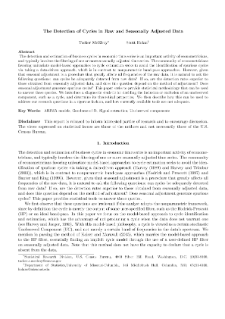
An official website of the United States government
Here’s how you know
Official websites use .gov
A .gov website belongs to an official government organization in the United States.
Secure .gov websites use HTTPS
A lock (
) or https:// means you’ve safely connected to the .gov website. Share sensitive information only on official, secure websites.
-
//
- Census.gov /
- Library /
- Census Working Papers /
- The Detection of Cycles in Raw and Seasonally Adjusted Data
The Detection of Cycles in Raw and Seasonally Adjusted Data
The Detection of Cycles in Raw and Seasonally Adjusted Data
Abstract
The detection and estimation of business cycles in economic time series is an important activity of econometricians, and typically involves the filtering of one or more seasonally adjusted time series. The community of econometricians favoring univariate model-based approaches to cycle estimation seeks to avoid the identification of spurious cycles via taking a data-driven approach, which is in contrast to nonparametric band-pass approaches. However, given that seasonal adjustment is a procedure that greatly affects all frequencies of the raw data, it is natural to ask the following questions: can cycles be adequately detected from raw data? If so, are the detection rates superior to those obtained from seasonally adjusted data, and does this question depend on the method of adjustment? Does seasonal adjustment generate spurious cycles? This paper seeks to provide statistical methodology that can be used to answer these queries. We introduce a diagnostic statistic for deciding the inclusion or exclusion of an unobserved component, such as a cycle, and determine its theoretical properties. We then describe how this can be used to address our research questions in a rigorous fashion, and how currently available tools are not adequate.
Others in Series
Working Paper
Working Paper
Working Paper
Share
Related Information
Some content on this site is available in several different electronic formats. Some of the files may require a plug-in or additional software to view.
 Yes
Yes
 No
NoComments or suggestions?


Top

